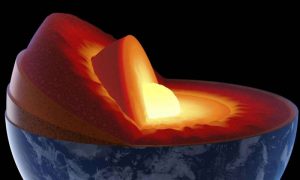
A team of scientists, including one at Lawrence Livermore National Laboratory (LLNL), has found that the dehydration of chlorite is likely to be crucial in explaining the anomalously high electrical conductivity observed in the Earth’s mantle.
The high electrical conductivity (EC) in the mantle wedge regions between depths of 40 and 100 km is often attributed to the aqueous fluid released from descending slabs. It is well known that mantle silicate minerals are electrical insulators with large electronic band gaps of around 7.5 to 9.5 electron volts (eV) at room temperature.
Laboratory-based measurements of the electrical conductivity of hydrous phases and aqueous fluids are significantly lower and cannot readily explain the geophysically observed high electrical conductivity. The released aqueous fluid also rehydrates the mantle wedge and stabilizes a suite of hydrous phases, including serpentine and chlorite.
The new research, appearing in the May 6 edition of the journal Science Advances, shows that the EC of chlorite is similar to other hydrous silicate minerals. The EC has a weak or no-pressure dependence but varies significantly with temperature.
“We have measured the electrical conductivity of a natural chlorite at pressures and temperatures relevant for the subduction zone setting,” said Davide Novella, a geophysicist at LLNL. “In our experiment, we observed two distinct conductivity enhancements when chlorite is heated to temperatures beyond its thermodynamic stability field. The initial increase in electrical conductivity can be attributed to chlorite dehydration and the release of aqueous fluids. This is followed by a unique, subsequent enhancement of electrical conductivity.”
The team found that the further increase in EC is related to the growth of an interconnected network of highly conductive and chemically impure magnetite mineral phases.
“The dehydration of chlorite and associated processes are likely to be crucial in explaining the anomalously high electrical conductivity observed in mantle wedges,” Novella said. “Chlorite dehydration in the mantle wedge provides an additional source of aqueous fluid above the slab and also could be responsible for the fixed depth (120 ± 40 km) of melting at the top of the subducting slab.”
Reference:
G. Manthilake et al. Dehydration of chlorite explains anomalously high electrical conductivity in the mantle wedges, Science Advances (2016). DOI: 10.1126/sciadv.1501631
Note: The above post is reprinted from materials provided by Lawrence Livermore National Laboratory.









